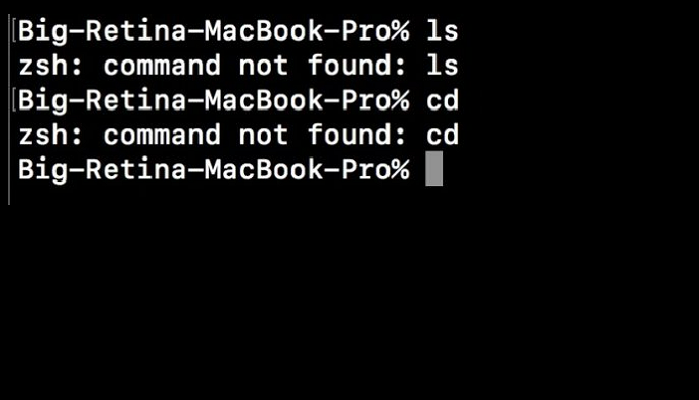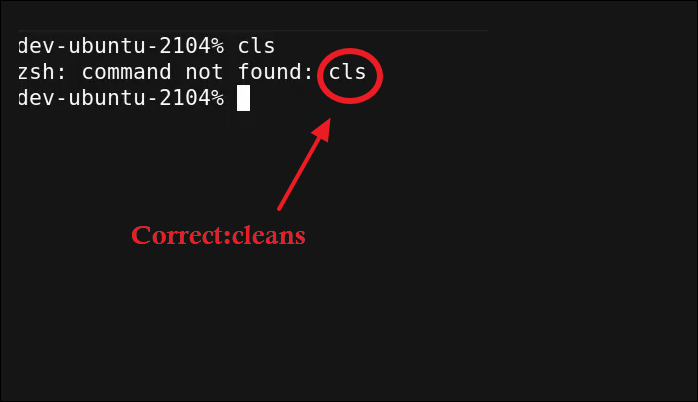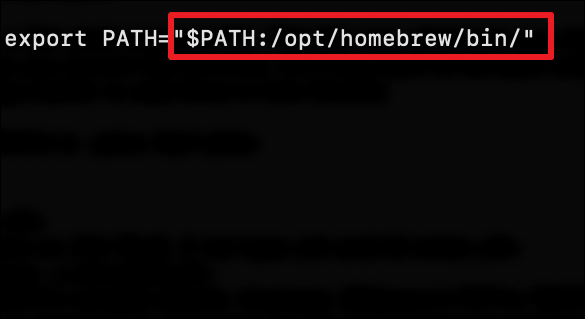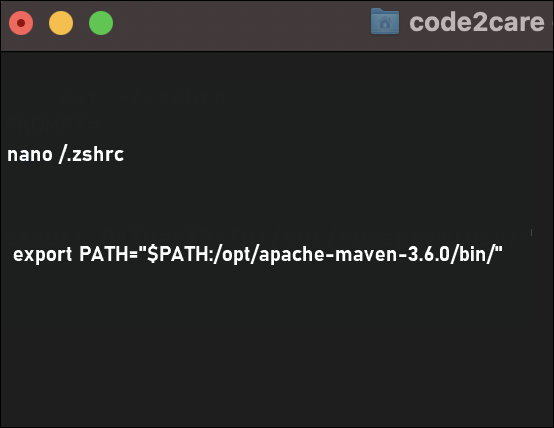5 Proven Ways to Fix Zsh Command Not Found Error on macOS [Bash & Zsh]
MacOS Catalina and later versions, including Big Sur, Monterey, and Ventura, switched from Bash to Zsh as the default login shell. This change may cause some Zsh commands to be inaccessible after a system update, resulting in errors like "Zsh: command not found". Users may encounter this issue with specific commands, such as brew, pip, nvm, or npm, due to various reasons.

The Reasons for Zsh Command Not Found Error on Mac
When using Unix, Linux, or macOS, many users encounter the "Zsh command not found" issue, prompting them to search forums for a solution. This problem can be caused by several reasons, including [list the reasons]. To resolve the issue, [provide the solutions].
1. Misspelled Zsh commands on MAC
When using Zsh commands on Mac for the first time, users often make mistakes like adding extra symbols or forgetting to include a space where needed, which can lead to the "zsh command not found" error. To resolve this, double-check the command for accuracy, ensuring it is correctly spelled and formatted. This will help prevent command errors and ensure successful execution.

2. The command is valid, but the package is not installed
When users encounter the error "Zsh command not found", it's likely because they're trying to run a command that requires a specific package to be installed, but that package is missing. To resolve this, users should verify that the necessary package is installed, ensuring they have the correct package for the command they're trying to run.
3. The change of default environment configuration of the Zsh command
When macOS updates to a new version, the typical environment of orders changes, where most Linux bash commands are stored but are unsuitable for Zsh commands. This is because, by default, Zsh does not read environment variables from the previously specified address.
How to Fix Zsh Command Not Found Error With 5 Solutions
The "Zsh: command not found" issue on a Mac can occur in various situations, including on macOS Monterey or any other macOS version that uses z-shell.
If you still have questions about fixing the error, please continue to read the solutions below.
- 1. Check the Syntax
- 2. Ensure the Package Is Installed
- 3. Set $Path Environment
- 4. Set Path in the .zshrc File
- 5. Reinstall the macOS
Solution 1. Check the Syntax When Zsh Command Not found
When using Mac's Terminal and receiving the "Zsh: command not found" message, first verify the command's syntax by copying the original content into the Terminal instead of manually typing it. Compare your command with other examples that use the same command to ensure accuracy.
Solution 2. Ensure the Package of the Zsh Command Is Installed
If you're frequently trying to perform a command, but the necessary package isn't installed, you should check if the required package is installed on your Mac. This can be done by ensuring you didn't forget to install the command's package, even if the Zsh command is correctly spelled and valid.
Solution 3. Set $Path Environment to Fix Zsh Command Not Found
To resolve the Zsh: command not found error, verify that the "$PATH" environment variable is configured correctly, ensuring that the directory containing the command is included in the path.
If you've installed the package but are still receiving the "Zsh: command not found" error, something is wrong. This indicates that you need to create a PATH variable for your command package.
Here is an example of setting an export PATH:

Most packages automatically set the path variable, but when performing a custom installation, you might occasionally need to set up path variables in Linux or macOS manually.
Solution 4. Set the Zsh Command Path in the .zshrc File
When you exit and re-To resolve the issue, log in to the Terminal after installing the package and setting up the path variable, but still see the error "Zsh command not found". Configure the command path in the .zshrc file to make it proper. This can be done by adding the package's executable path to the command's path in the .
Your .zshrc file will run and set the command path each time you close and reopen the Terminal. To edit the file, follow these steps: [insert steps here].
Step 1. Open the macOS terminal.
Step 2. Verify that you are using the Zsh Shell; if not, type zsh and press the Enter key to check. If you are already using Zsh, you can skip this step.
Step 3. Type nano /.zshrc on the window.
Step 4. Add your $PATH variable information now

Step 5. To save the file, hit Control + X, then Y, and finally Enter to close the Nano editor.
Step 6. To commit changes, execute command source /.zshrc now.
Solution 5. Reinstall the macOS to Fix the Zsh Command Not Found
If you've accidentally deleted system files or folders while exploring macOS, you may need to recover deleted files on your Mac. This can happen if you've been rooting around in the system and inadvertently deleted files required for Terminal commands. To resolve this, you should attempt to recover the deleted files.
To reinstall macOS without formatting the drive, you can retain your previous settings and fix the Zsh command not found issue. However, it's still recommended to create a backup of your crucial files before proceeding, as reinstalling the operating system may not guarantee data safety. If you're unable to locate your important data after the reinstall, you can try recovering files using available methods.
Additional Information: How to Recover Deleted Data on Mac
Reinstalling macOS can be a helpful method to fix the Zsh command not found error, as we mentioned in Solution 5. Additionally, restoring deleted files on Mac after reinstalling or updating is also crucial.
Protecting your data is crucial, as incorrectly updated processes or wrong commands could result in losing your files and data. To safeguard against this, consider using a reliable tool like Deep Data Recovery for Mac, which can help recover your data in case of an issue.
To recover deleted files on your Mac, follow these steps: first, check if the files are in the Trash and restore them from there if possible. If the files are not in the Trash, use software like Disk Drill, EaseUS Data Recovery Wizard, or Wondershare Data Recovery to scan your Mac's hard drive for deleted files.
Step 1. Select file types
Launch Deep Data Recovery software, select the desired file types, and click "Next" to initiate the recovery process.

Step 2. Select the location and scan
Select the disk where the data was lost, and click on "Scan" to initiate the scanning process.

Step 3. Filter and preview lost files
After the scan, use the file format filter on the left or upper right corner to find the deleted files you need.

Step 4. Recover lost data or files
You can double-Click on a file to preview its content, or select multiple files to recover them simultaneously. Then, click "Recover" to restore the lost data to a local or cloud drive.
To Wrap It up
The "Zsh command not found" issue arises from compatibility differences between the bash shell and Zsh shell, particularly on different macOS versions. If you've recently updated your Mac and encounter this problem, the solutions provided may be helpful. Additionally, using Deep Data Recovery for Mac can ensure your data is safely secured on your Mac devices.
Zsh Command Not Found FAQs
Here, we included 4 questions that you may also be interested in. Check and find the answers here.
1. Is Zsh default on Mac?
On Macs running macOS Catalina or later, zsh (Z shell) is the default shell. However, on earlier macOS versions, Bash remains the default.
2. How do I start Zsh on Mac?
Open the "Shell" tab - click "Run command" - type "zsh".
3. How to open the Zsh terminal on Mac?
- Step 1. Click the Launchpad icon in the Mac's Dock
- Step 2. Search "Terminal" in the field
- Step 3. Click Terminal.
- Step 4. Type "Zsh" to launch it.
4. How do I fix macOS's "Zsh: command not found brew" error?
Ensure you have installed the brew right and the path variable is set up correctly.
- Step 1. Open the .zshrc file with the command nano /.zshrc.
- Step 2. Add the following code to the file: export PATH="$PATH:/opt/homebrew/bin/"
- Step 3. Save the file using Control + Enter and X.
- Step 4. To apply changes, type source /.zshrc in the command line.
Related Articles
- [4 Easy Ways] How to Backup SD Card on Samsung
- How to Free Up Space on SSD in Windows 10/8/7
- How to Stop Windows 10 Update in Progress in 3 Ways
- Fix: Windows 10 Update Stuck Checking for Updates